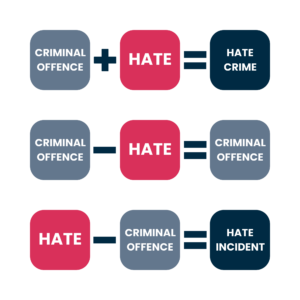We know that “hate” is a strong word and conversations about hate, discrimination, and oppression can be triggering and confusing. Our vision is a Hamilton community where we all belong, and to emphasize peace, compassion, and inclusion. But to do this, we believe we must face the issue of hate head on, including understanding its root causes. This includes using language to describe hate, and understanding how it appears in our communities, institutions, and systems.
Some expressions of hate are universally recognized and understood. These include the painting of swastikas on buildings, attacking people at a Pride event, or the killing of a family in London in 2021. Some hate is policed under the Criminal Code as “hate crimes”. But not all expressions of hate are so obvious.
We use the term “hate” broadly and inclusively in this Toolkit. Hate includes:
This understanding of the term requires all of us—as individuals, as well as our organizations and institutions—to recognize our shared roles in dismantling racism and oppression that fuel hate.
Sometimes, the terms “hate crimes” and “hate incidents” are used interchangeably, but they don’t actually mean the same thing.
A hate crime is a criminal offense that’s motivated by hate, bias, or prejudice against any group. Examples of criminal offenses include violence, property damage, or assault (i.e., hitting or spitting on someone). When these crimes are combined with hate that intentionally targets individuals from marginalized communities, they are called “hate crimes”1.
On the other hand, hate incidents refer to behaviours that are motivated by hate but aren’t crimes. Examples of hate incidents include racial slurs or insulting someone because of their ethnic or religious dress or how they identify1. Even though these actions aren’t crimes, they are still extremely harmful and can lead to emotional and psychological trauma.
Here is a diagram that shows the differences between hate crimes, criminal offenses, and hate incidents1.

These videos describe the distinction between hate crimes and incidents that arise from hate but aren’t classified as crime:
Introduction to the Anti-Hate Toolkit
The Belonging Pledge
Individual Pathways
Introduction to Pathways for Individuals
Anti-Racism and Anti-Oppression Pathway
Stakeholder Pathways
Introduction to Stakeholder Pathways
Recommendations for All Stakeholders
Resources for Parents/Caregivers
Inclusive Practices